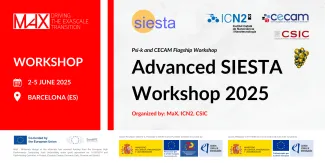
Between 2-5 June, 2025, the MaX Centre of Excellence co-organized the Advanced SIESTA Workshop in Barcelona, bringing together researchers and experts to explore machine learning, high-performance computing, and emerging applications in density functional theory.
The Advanced SIESTA Workshop, co-organized by the MaX Centre of Excellence for Materials at the eXascale, took place from June 2 to 5, 2025, at the Catalan Institute of Nanoscience and Nanotechnology (ICN2) in the Barcelona area. During the four days of the workshop, researchers from across Europe and beyond gathered to exchange knowledge, discuss new ideas, and receive hands-on training on advanced uses of the SIESTA method in computational materials science.
This school represented a key step in MaX’s mission to empower the scientific community to fully exploit exascale computing for materials discovery. The event provided a platform to showcase the ongoing progress in simulation tools and promote best practices in sustainable, interoperable, and scalable computational workflows.
SIESTA is one of the MaX Lighthouse codes for large-scale materials simulations using density functional theory. Throughout the workshop, participants explored its application to electronic transport, magnetism, superconductivity, electrochemistry, thermal properties, and its growing integration with machine learning techniques and high-performance computing architectures.
By bringing together leading experts and early-career researchers, the workshop strengthened collaboration within the materials modeling community and reinforced the relevance of high-performance simulation tools in driving innovation across fields such as clean energy, electronics, and catalysis.
Program Highlights:
Monday, June 2 – Electrochemistry and Transport:
The event opened with registration and a welcome session. Dr. Ernane de Freitas Martins presented electrochemical simulations using TranSIESTA and QM/MM. In the evening, Prof. Aran Garcia-Lekue delivered a presentation on electronic transport simulations using SIESTA.
Tuesday, June 3 – Magnetism and Superconductivity:
Dr. Nick Papior discussed post-processing tools like sisl and the LUA interface for SIESTA automation. Dr. He Xu followed with a deep dive into spin-orbit coupling and magnetic exchange using TB2J. Afternoon sessions included talks on superconductivity by Dr. Zeila Zanolli and a DMFT showcase by Prof. Aldo Romero. A social dinner concluded the day.
Wednesday, June 4 – Electron-Phonon Coupling and HPC:
The day began with Prof. Matthieu Verstraete presenting on advanced material properties derived from SIESTA outputs. Dr. Miguel Pruneda focused on electron-lattice interactions. Dr. Bogdan Guster explored Fermi surface nesting and Lindhard functions. Later, Dr. Alberto García led a roundtable on SIESTA workflows and delivered a practical showcase on GPU-enabled exascale computing.
Thursday, June 5 – Machine Learning and Future Directions:
The final day began with Dr. Pol Febrer discussing how machine learning accelerates molecular dynamics within SIESTA. This was followed by a session chaired by Dr. Nick Papior on SIESTA’s role in ML-based materials modeling. Dr. Federico Pedron presented on recent and upcoming developments in SIESTA, and the event concluded with an open discussion on high-throughput calculations and future research directions.
__________
Acknowledgement
The event was part of the CASTIEL2 "Training Sprint" and was proudly supported as a Psi-k and CECAM Flagship Workshop. It was made possible through the collaboration of the MaX Centre of Excellence, ICN2, and CSIC. We thank all participants and the organizing committee (Catalina Coll, José María Escartín Esteban, Roberta Farris, Federico Pedron, and Miguel Pruneda) for their exceptional effort and support.
__________
About SIESTA
SIESTA is a widely used open-source code for first-principles simulations based on density functional theory. Designed for efficiency and scalability, SIESTA enables researchers to simulate complex materials and interfaces with thousands of atoms. Its rich ecosystem of interfaces and compatibility with machine learning tools ensures its continued role in cutting-edge materials science.